Can Boeing Boing Back Now?📌
Saga: Fixin’ to Fly Right? (Premise).
Update: (12/10/21)—The FAA continues to throttle down Boeing’s production➬certification parade by refusing to allow the planemaker to continue steps toward the airworthiness of its huge widebody 777X, likely delaying that inspection process until Q3-4, 2023. This comes amid the aerospace giant’s mounting safety/control issues (up and down its product line) with the now more exacting aviation agency.
![]() In fact, even fit-and-finish delays with the company’s 787 Dreamliner are causing American Airlines to scale back it Trans-Atlantic flights/capacity for summer, 2022. It and other carriers are looking more closely at walking away from their contracts with the prospect that Boeing will be unable to deliver on Dreamliner orders in a timely fashion.☟
In fact, even fit-and-finish delays with the company’s 787 Dreamliner are causing American Airlines to scale back it Trans-Atlantic flights/capacity for summer, 2022. It and other carriers are looking more closely at walking away from their contracts with the prospect that Boeing will be unable to deliver on Dreamliner orders in a timely fashion.☟
Otherwise, the FAA has also cited a need for more X test flights and further data review to ascertain “the maturity and safety…of the 777X aircraft.” Particularly concerning FAA officials was a flight control incident December 8, 2020. Termed an “uncommanded pitch event”, the Model X abruptly nosed up and down without pilot direction on a test flight. The agency asserted that Boeing has not since convinced regulators that it has fully grasped and corrected the flight control system’s hardware and software problems.
The FAA also determined that the planemaker’s proposed redesign of the new variant’s aviation ‘common core’ system (for shared multi-computing power onboard) did not meet “expected (regulatory) 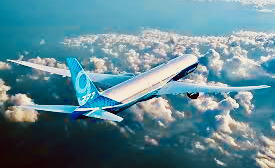 requirements.” A frustrated agency official said, “…there’s a general feeling that Boeing has kind of lost a step” relative to its historically lofty engineering reputation—as if there was something in the air between Chicago and Seattle…or not. And, he added, “the days of Boeing being able to say to the FAA ‘Just trust us’ are long gone.”
requirements.” A frustrated agency official said, “…there’s a general feeling that Boeing has kind of lost a step” relative to its historically lofty engineering reputation—as if there was something in the air between Chicago and Seattle…or not. And, he added, “the days of Boeing being able to say to the FAA ‘Just trust us’ are long gone.”
The chastened federal agency stressed once again that safety is paramount with regard to its judgments and timelines, and it “…will not approve any aircraft unless it meets our safety and certification standards.” In response, the Chicago-based aerospace giant stated it “remains fully focused on safety as our highest priority throughout 777X development.”
Slow But Sure (Demand-wise)?
The X was originally introduced in 2013 as a super long stretch of the successful 777 to replace retiring 747s and Airbus A380 SuperJumbos. It features immense carbon composite wings with folding tips, and 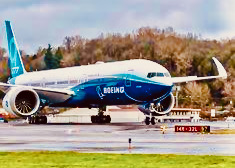 the largest jet engines (GE9X) ever made. A 777-9X variant, first test flown in January 2020, will seat 426 passengers in two-class mode—intended for long-haul air carriers such as Lufthansa, Qatar, Emirates and All-Nippon Airways.
the largest jet engines (GE9X) ever made. A 777-9X variant, first test flown in January 2020, will seat 426 passengers in two-class mode—intended for long-haul air carriers such as Lufthansa, Qatar, Emirates and All-Nippon Airways.
Still, the current FAA ‘Type Inspection Authorization’ (TIA) speed bump puts paid to all that, pushing the 777X’s launch into commercial service back to 2024, some four years later than Boeing intended. At the same time, air traffic levels are rapidly returning to 2019 levels, and carriers are demanding new cleaner, more fuel efficient aircraft–particularly smaller, single-aisle models. While orders for Boeing’s 737 MAX 9/10 iterations are steadily increasing, Airbus is struggling to deliver its popular, most profitable A320neo (and longer-range A321XLR), due to supply chain bottlenecks on parts and components (some 500k required per plane).
So it appears the FAA’s TIA regulatory stall on the massive 777X couldn’t have come at a more precarious time. (MTC…)
Update: (7/14/21)—As if Boeing’s problems haven’t beset it to the MAX, a chastened, newly assertive ![]() FAA has just levied some $17m in penalties against the Chicago-based aerospace giant for multiple shortfalls in the production of its 737 NG model, as well. Specifically, the agency charged that the planemaker designed and installed unapproved sensors on 759 737s, and submitted 178 MAXes for airworthiness certification with ‘nonconforming’ slat tracks. The latest penalties constitute a reduction from the $25.1m sanction initially proposed by the agency. A settlement agreement requires Boeing to complete stipulated corrective actions and pay the fine within 30 days, or incur up to $10.1m in additional penalties. This hit comes alongside the troubled company’s on again-off again delivery of fully airworthy 787 Dreamliners—which has been further stalled by problems with the 787’s fuselage fit and finish (i.e., joins and forward pressure bulkheads). According to the FAA, this latest (near-nose cone) issue pertains to all undelivered Dreamliners, but does not pose a flight safety hazard. Nor does it immediately affect 787s in current commercial service.
FAA has just levied some $17m in penalties against the Chicago-based aerospace giant for multiple shortfalls in the production of its 737 NG model, as well. Specifically, the agency charged that the planemaker designed and installed unapproved sensors on 759 737s, and submitted 178 MAXes for airworthiness certification with ‘nonconforming’ slat tracks. The latest penalties constitute a reduction from the $25.1m sanction initially proposed by the agency. A settlement agreement requires Boeing to complete stipulated corrective actions and pay the fine within 30 days, or incur up to $10.1m in additional penalties. This hit comes alongside the troubled company’s on again-off again delivery of fully airworthy 787 Dreamliners—which has been further stalled by problems with the 787’s fuselage fit and finish (i.e., joins and forward pressure bulkheads). According to the FAA, this latest (near-nose cone) issue pertains to all undelivered Dreamliners, but does not pose a flight safety hazard. Nor does it immediately affect 787s in current commercial service.
☟Nevertheless, FAA Administrators reiterate that keeping the skies and flying public safe is the agency’s primary responsibility: an auspicious sign of rededication, given past Boeing-FAA ‘coziness’. (MTC…)
![]() 1/30/21—The planemaker’s woes continue into the new year as Boeing has just reported a massive $11.9b net loss for 2020, the largest in company history. This, after posting annual revenue of $100b two short years ago.
1/30/21—The planemaker’s woes continue into the new year as Boeing has just reported a massive $11.9b net loss for 2020, the largest in company history. This, after posting annual revenue of $100b two short years ago.
In an investor conference call, now CEO Dave Calhoun cited tighter certification requirements and coronavirus ravaged air travel market demand. Add in delayed or cancelled deliveries, millions of dollars in myriad charges (as per 737 MAX-related penalties and compensation), along with even more problems up and down Boeing’s product line—which may weigh on the company well into 2023.
More specifically, despite surprisingly growing international demand for the efficient widebody 787 Dreamliner in post-pandemic, long-haul carrier plans, that variant remains bogged down in problems with various defective joins its carbon-fiber composite fuselage and inferior/ill-fitting cockpit windows, stalling production in Boeing’s Everett and South Carolina assembly plants.
As for the latest 777X, regulators are requiring design modifications on the top-line model’s actuator control electronics for mechanical devices that operate key control components such as the horizontal stabilizer, vertical tail rudder, flaps and wing panels—along with X’s long folding wingtips.
And even though the 737 MAX is slowly but surely passing recertification inspections and re-entering service, the ungrounded planes (over 410 still parked and stored) will not be generating income any time soon. Nevertheless, Boeing’s advance payment cushion burns steadily away, as it prepares corporate properties (as in Renton, WA) and other real estate for sale.
Would that the company’s current models had the long-tail staying power of its cold war workhorse
B-52 Stratofortress, still the USAF’s bomber mainstay to this day. Maybe the venerable company should have never moved its headquarters to a distant railroad town like Chicago. Better to bring it all back home to Seattle/Puget Sound, where the global aviation giant actually built its greatness?
![]() In any case, the new order-to-cancellation ratio for both 737 MAXes and 787 Dreamliners is now climbing, however slowly, in Boeing’s favor. (MTC…)
In any case, the new order-to-cancellation ratio for both 737 MAXes and 787 Dreamliners is now climbing, however slowly, in Boeing’s favor. (MTC…)
Update: (10/31/20)—In the wake of news that FAA honcho, Steve Dickson has personally flight tested and approved of Boeing 737 MAX’s Maneuvering Characteristics Augmentation System (MCAS) modifications, the agency has issued a draft report on revised pilot training procedures applicable to all 737 series aircraft.
The Flight Standardization Board (FSB) report flows from proposals developed by the FAA in concert with civil aviation authorities from Canada, Brazil and the European Union (comprising a Joint Operational Evaluation Board). The finding recommends full-motion flight simulator training, including procedures for responding to multiple MCAS flight deck alerts during abnormal flying conditions, along with runaway stabilizer malfunctioning. The FSB report also requires an added vane to the current single MAX Angle-of-Attack (AofA) sensor—that is, one on each side of the plane’s nose—to lessen the possibility of MCAS activating on the basis of a lone sensor’s faulty data.
The latest training revisions are in response to the troubled flight control system’s role in both the LionAir and Ethiopian Airlines disasters. Of principal concern has been MCAS’s tendency to overreact to such perceived airspeed input that the aircrafts’ attitude was (wrongly) pitching overly upward, potentially causing a dangerous nose-up stall. Thus the computerized system signaled a horizontal tail to swivel and push the jets nose down—perilously continuing to do so, no matter how pilots might attempt to manually circumvent the automated correction.
Accordingly, the FSB report stipulates that 737 (particularly MAX) pilots undergo training on swiftly recognizing a runaway stabilizer malfunction, and responding to a new alert indicating the horizontal flap is out of position. Likewise if the mandated dual AofA sensor airspeed readings conflict or are otherwise faulty. Incorporated in the simulator training are procedures on cutting off electrical connection to the horizontal tail, and trimming the horizontal flap via manual a cockpit wheel to correct any untoward nose-down pitch. Remedial checklists also cover seven different emergency scenarios.
Beyond that, the FAA must approve all software upgrade requirements and other 737 MAX revisions before it can issue a final ungrounding order for the beleaguered Boeing model. Public review and comment on the report will continue through November 2 on the FAA website, with MAX recertification not expected before mid-November 2020, in preparation for takeoff into more turbulent skies.
Trimming Sales and Flaps.
In the meantime, the company is resizing, reshaping its entire business in adapting to the new aviation market realities (namely more defense and space programs). It hasn’t delivered any 737 new MAX models since early spring 2019, and order cancellations are rising to nearly 500. Overall, Boeing has delivered only 98 commercial jets in 2020 thus far, as opposed to over 300 to this point in 2019. The aviation giant has now reported that it lost $466m in Q3, the fourth straight quarterly decline, facing a 30% drop in revenue in 2020 thus far, a debt load of $61b with $27b on hand and a sinking stock price. So it will cut 7,000 more jobs, leaving its workforce down 20% from pre-pandemic levels. Even more trimming may come via attrition, layoffs and buyouts, amid cratered demand, a jetliner glut and continued travel contraction worldwide.
Clearly, hardest hit is Boeing’s Commercial Airplanes (CA) division, because beyond its 737 MAX debacle, the outlook for new long-haul 777Xs is little better, while finished 787 Dreamliners are already parked/ stored in deserts up and down the west coast. As a result, the planemaker’s idea is to close its CA Headquarters in Longacre, WA; to shed this fixed division HQ concept altogether, becoming ‘lean and ready’ if and when the ‘deeply impactful’ MAX/pandemic nosedive levels off.
For its part, rival Airbus has shipped 40% fewer planes than in 2019. Nevertheless, the European rival’s A320neo and A321neo models have by now eclipsed Boeing’s 737 MAX on single-aisle airliner sales the world over. In any event, we’ll soon see how effectively the MAX can relaunch and rebound. (MTC…)
Update: (10/1/20)—While Chicago-based Boeing prepares to completely move 787 Dreamliner production from Everett, WA to its plant in South Carolina, a consolidation prompted by dwindling orders, a positive development:
Chief FAA Administrator, Steve Dickson, a former Delta Airlines captain, personally put an updated 737 MAX through its paces September 30 on a flight from Boeing Field to a Moses Lake, WA air facility and back. His verdict? Dickson declared that the revamped MAX and its redesigned Maneuvering Characteristics Augmentation System (MCAS) control technology handled well, particularly its high angle of attack patterns. He described the system as “benign” so long as a pilot maintains manual tail control as needed.
Dickson’s satisfaction, though not an official stamp of approval, could nonetheless prove to be a crucial step in the MAXs’ recertification process. Some critics called the test flight a “Public Relations gift to Boeing”, but the FAA head stressed that his personal piloting of the craft is key to his leading the ungrounding protocols “from the front” and “getting decertification right.”
The next hurdle involves publishing an agency 737 MAX pilot retraining report for public review and comment. A final examination of the MAX’s redesign documentation by the Technical Advisory Board (TAB) of nine civil aviation authorities worldwide, NASA and the FAA would follow. And Vamigré will surely follow those developments, as well. (MTC…)
Update: (8/11/20)—According to the Federal Aviation Administration’s most recent recertification plan, what Boeing and air carriers need do to return the 737 MAX to service include the following:
-
-
- Design a software fix to the Maneuvering Characteristics Augmentation System (MCAS) flight control technology that will process input from two Angle of Attack (AofA) sensors, rather than the original, failed single vane approach.
- Further, in the event that MCAS is activated, it must now only be able to override pilots’ maneuvers one time, not over and over, as the system did in both fatal LionAir and Ethiopian Air flights.
- MCAS control of MAX’s horizontal tail must also be attenuated, better enabling pilots to counter system flap angling by physically pulling back on the control column and/or cranking the manual trim wheel. Moreover, on the back end, control wiring to the horizontal stabilizer will be rerouted to separate bundles, so as to avert potential electrical shorts that could reposition the horizontal tail over pilots’ intentions, if not awareness.
- Create another software fix that adds an instrument panel alert to be triggered when the two AofA sensor vanes are in disagreement.
- Training standards for pilot checklist modification include not hitting horizontal stabilizer cutoff switches before pressing main electric thumb switches on the control column to adjust aircraft pitch and ease pressure on the horizontal tail. Also, even in the tail’s maximum position, a two-pilot ability to physically control the manual trim wheel must be advanced, beyond their simply reducing airspeed to lower forces on the tail flaps.
-
The FAA notes that it provided direct oversight on the development of these design changes— “a thorough, transparent process that remedies MCAS safety issues, meeting all reliability and integrity safety 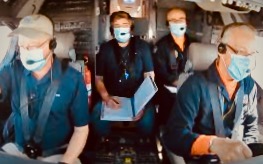 requirements”—without delegating any supervisory aspects to Boeing itself. The agency further states that its proposal is product of an 18+ months’ review, 60,000 hours of document and certificate testing, 50 hours of flight/simulator trials—as well as 4,000 such hours by the manufacturer. The final FAA plan also incorporates recommendations from an independent Technical Advisory Board of experts from various governmental agencies around the world.
requirements”—without delegating any supervisory aspects to Boeing itself. The agency further states that its proposal is product of an 18+ months’ review, 60,000 hours of document and certificate testing, 50 hours of flight/simulator trials—as well as 4,000 such hours by the manufacturer. The final FAA plan also incorporates recommendations from an independent Technical Advisory Board of experts from various governmental agencies around the world.
Published in the Federal Register, the FAA documents will be open to comment (for 45 days at 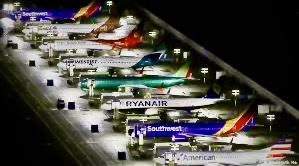 regulations.gov)—by airline operators, industry experts and the general public alike. Meanwhile, Congress piles on with a final report that chastises the FAA and Boeing for the MAX disasters, recommending much more stringent supervision of the aviation agency, notably its relationship with the manufacturer it is charged with overseeing (this, published way little and late).
regulations.gov)—by airline operators, industry experts and the general public alike. Meanwhile, Congress piles on with a final report that chastises the FAA and Boeing for the MAX disasters, recommending much more stringent supervision of the aviation agency, notably its relationship with the manufacturer it is charged with overseeing (this, published way little and late).
Still, if all flies right, final Airworthiness Directive If all flies right, final Airworthiness Directive clearance for the 737 MAX could come by late October. Thereupon air carriers can modify, test their MAX fleets, and re-train their pilots in 1-2 months’ time—all with the goal of ending the beleaguered variant’s nearly two-year grounding before the usually busy holiday season arrives.
That is, if the FAA’s plan actually does get off the ground, 737 MAXes do take to the skies once more as anticipated. And there are paying passengers willing to board them. (MTC…)
Update: July 2020—Setting September-to-October coordinates for the re-certification of its long grounded 737 MAXes, the Boeing Corporation is now focused on resumed production and delivery of its troubled narrow-body jets.
If only the airlines were in a position to receive them, let alone re-deploy the MAX variants they already have parked and stored worldwide.
Nevertheless, after a series of rather promising recent MAX test flights, the Chicago-based manufacturer couldn’t be more eager to roll out their 737 mainstay from its Renton, WA plant once again. Because so far, 2020 has been a 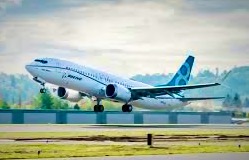 disastrous year for Boeing overall. The giant planemaker has produced just 70 aircraft in the first six months, as compared to 239 by the same time in 2019—delivering but 10 in June, only three passenger jets at that, the rest freighter configurations.
disastrous year for Boeing overall. The giant planemaker has produced just 70 aircraft in the first six months, as compared to 239 by the same time in 2019—delivering but 10 in June, only three passenger jets at that, the rest freighter configurations.
Same time, the company lost (or risked losing) over 800 MAX orders in the first half. Moreover, carriers such as Emirates and Qatar Airlines have also delayed delivery of the engine-stalled 777X, as well as 777S and 787S cargo jets. Little wonder Boeing cut 16,000 jobs in April, amounting to 1/10th of its total workforce.
Rival Airbus has fared little better, for one thing grounding nearly 120 A380 SuperJumbos since early March. This while recent International Air Travel Association (IATA) data cites 91% fewer global travelers in May over 2019, primarily due to coronavirus concerns. But no question, the COVID-19 pandemic and MAX fiasco have dealt Boeing a strikingly brutal one-two punch.
Demand-wise, the sweeping travel/tourism shutdown has driven many cash-strapped airlines into steep financial distress, some nosediving toward bankruptcy. Losing hundreds of millions of dollars by the day—a $50 billion federal April grant notwithstanding. Carriers face a grim adapt, shrink or die conundrum, if not a years-long recovery climb to 2019 traffic levels, which clearly casts a downdraft on near-term aircraft buying sprees.
Still, the 737 MAX remains an efficient narrow-body passenger aircraft with a solid order backlog of 3,550 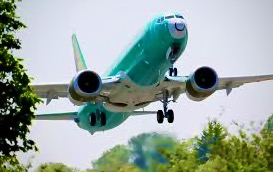 copies. Boeing claims that its ultra-modern jet will afford significant cost savings in fuel and fleet maintenance over the long haul. And with current discounted per-plane price tags (up to 50% off a $135m list), not to mention costly cancellation clauses in already inked purchase contracts, chances are air carrier customers will be unlikely to jump ship today—or tomorrow, for that matter.
copies. Boeing claims that its ultra-modern jet will afford significant cost savings in fuel and fleet maintenance over the long haul. And with current discounted per-plane price tags (up to 50% off a $135m list), not to mention costly cancellation clauses in already inked purchase contracts, chances are air carrier customers will be unlikely to jump ship today—or tomorrow, for that matter.
But that brand loyalty may further hinge on the entire MAX fleet’s proving worthy of an FAA airworthiness directive and re-certification this autumn. So in the company’s eyes, September, even October can’t come soon enough, if Boeing is to boing back to its global aviation prominence. (MTC…)
Backdraft: (2/20/20)—Two planes fatally down, a fleet of 737 MAXes grounded, fingers being pointed, the clock and meters still ticking away…
Since those Congressional hearings last fall, headwinds had intensified for Boeing under the leadership of Dennis A. Muilenburg. The entire 737 MAX variant remained grounded, 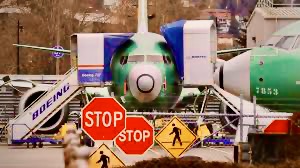 stored on airstrips all over Washington state—with some 5,000 orders being undeliverable. Restive airline customers like American, Southwest and UAL (plus fleet lessors) have pushed back fly-date deployment of their (partially prepaid) MAX aircraft until fall, 2020 or later, calculating the potential impact on the upcoming summer travel season, now deferring further payments, demanding Boeing compensation. United alone forecasts cancelling over 13,800 flights through early June.
stored on airstrips all over Washington state—with some 5,000 orders being undeliverable. Restive airline customers like American, Southwest and UAL (plus fleet lessors) have pushed back fly-date deployment of their (partially prepaid) MAX aircraft until fall, 2020 or later, calculating the potential impact on the upcoming summer travel season, now deferring further payments, demanding Boeing compensation. United alone forecasts cancelling over 13,800 flights through early June.
Shifting Priorities and Pushback.
Their wings clipped, Boeing management fully halted 737 production at the Renton, WA plant (a $4b stopping/restarting proposition), vowing to reassign its already stressed workers rather than resorting to layoffs. The shutdown affects a supply chain of nearly 600 companies, from California to Kansas, Great Britain to France and across Asia. Some are already in ‘crisis mode’, bleeding revenue, juggling workforces, scrambling elsewhere for bluer skies. Other parts suppliers—from floor panels and duct work to avionics and entertainment systems—say they are facing a two-year MAX recession.
Wichita’s Spirit Aerosystems, for one, has suspended crucial fuselage production (the 737 program generates half of the company’s revenue), stacking 100 tarp wrapped assemblies in 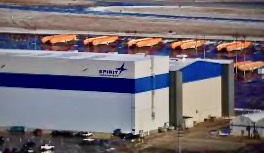 storage, planning to layoff 3,000 Wichita workers, others in Oklahoma. Meanwhile, GE/Safran is shifting more of its power plant resources to Airbus, which has been picking away at Boeing’s MAX/MCAS ruins.
storage, planning to layoff 3,000 Wichita workers, others in Oklahoma. Meanwhile, GE/Safran is shifting more of its power plant resources to Airbus, which has been picking away at Boeing’s MAX/MCAS ruins.
Up and down the 737 production chain, a balancing act involves paring costs against maintaining slowed or stalled workforces in readiness for a smooth restart if and when 737 MAXes resume flying. So Boeing plans to compensate 600 idling suppliers large and small upwards of $4b over the next 18 months to help support them until 737 MAX production does resume, if not countering more vendor deflections to Airbus SE. 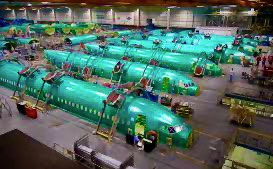 But as the company now concedes, any yoke of renewed takeoff is entirely in the hands of regulators worldwide, given the blowback the FAA has taken over its hands-off mishandling of Boeing’s oversight.
But as the company now concedes, any yoke of renewed takeoff is entirely in the hands of regulators worldwide, given the blowback the FAA has taken over its hands-off mishandling of Boeing’s oversight.
Case in point: The agency’s minimizing of, if not ignoring a high-risk assessment of continued 737 MAX airworthiness after Lion Air’s fatal crash. An internal FAA Transport Airplane Risk Assessment Methodology (TARAM) projected that the MAX could be one of the most accident-prone airliners in decades, posing a crash threat every three years of the variant’s 30-45 year lifespan. Little wonder the agency’s recertification screws are tightening like a wing-flap jackscrew.
Boeing management has found this increased administration friction a “very significant and negative development” that could delay a MAX relaunch even further. Then came the European Union Aviation Safety Agency ruling that EASA intends to perform “concurrent validation” of 737 MAX (and 777X) certification—further challenging the FAA’s global authority.
For his part, CEO Muilenburg endeavored to pressure the aviation agency into accelerating the recertification process by publicly announcing anticipated MAX re-fly dates—juking Boeing’s stock price like stunt plane touch-and-go’s. Muilenburg’s aggressive ‘optimism’ hastened pushback from current acting FAA head, Stephen Dickson to stop with the “unreasonable expectations” and ‘public lobbying’ routine.
Schedules over stringency, savings over safety: Boeing’s ensuing misguided ($410m) Starliner space shot only darkened the cloud cover over its beleaguered CEO all the more.
Mulling an Over and Out.
Muilenburg had led Boeing since July, 2015. The aerospace giant’s share price had since tripled, supercharged by skyrocketing jet production and parceling more profits to shareholders via higher dividends and stock buybacks as revenue rolled in. Moreover, he had struck stable long-term labor pacts, and reversed sliding defense sales.
Still, Muilenburg may have inherited the MAX/MCAS designs, but was in charge over the two years before the variant entered service in 2017. An engineer by training, Muilenburg had drawn on data and legal advice, in lieu of clear communications and/or sophisticated public relations, throughout the MAX ordeal.
Hence he was finally fired last December 21, unhappily so (albeit failing upwards with a parachute, including stock and pension benefits, nearing $80m!). This, amid the planemaker’s biggest crisis in decades—now  totaling over $9b and rising, in costs, lost revenue, fines and ($8.3b+) customer, victim) compensation liabilities.
totaling over $9b and rising, in costs, lost revenue, fines and ($8.3b+) customer, victim) compensation liabilities.
Jettisoned as well by Boeing’s Chicago-based board were Kevin McAllister, head of the Commercial Airplane Division, then J. Michael Lutting, retiring general counsel, who was facing a killer wave of crash-related lawsuits and ongoing criminal investigations. The former federal appeals court judge had been criticized for Boeing’s MAX/MCAS responses and attempting to cast blame for the Lion Air and Ethiopian Air crashes on the carriers’ “foreign” pilots.
Still, the clocks, meters keep ticking, amid The Fix’s ‘power up’ fits and starts…
Meet the New Boss…
After a brief interim CEO stint by CFO Gregory Smith, enter new Boeing CEO, David L. Calhoun. Chairman of Boeing’s board of directors, he now takes over 1st chair, vowing to restore brand confidence and chart a new direction for the planemaker—with Larry Kellner assuming the board chairmanship. Still, it is a governing board of big name, blue-chip, battle tested heavyweights—industry leaders, laureates and political players, all right—yet thin on engineering and aviation safety expertise.
Calhoun purportedly comes to the job with a “turnover specialist” reputation, from experience righting GE, Nielsen Data and Caterpillar. Since 2013, he has led the Blackstone Group’s operations and portfolio. He also brings longstanding ties to the aviation industry, so appears to be well familiar with the current Boeing imbroglio, and shouldn’t need months to bone up on it all.
Thus far, the incoming CEO has noted that Boeing indeed needs to change its current engineering approach, more evenly balancing with management and marketing. But beyond  technicals, design and bolstered pilot training, Calhoun is stressing better, clearer communication with customers, regulators—across the production lines (as opposed to spurning the Dutch investigation of a 737 crash near Amsterdam that killed nine in 2009). Or the Justice Department’s probe of whether former chief technical pilot Mark Forkner did lie to the FAA about MCAS simulator abnormalities.
technicals, design and bolstered pilot training, Calhoun is stressing better, clearer communication with customers, regulators—across the production lines (as opposed to spurning the Dutch investigation of a 737 crash near Amsterdam that killed nine in 2009). Or the Justice Department’s probe of whether former chief technical pilot Mark Forkner did lie to the FAA about MCAS simulator abnormalities.
Pledging to be more open, less controversial, he has already reached out to airlines, suppliers, union leaders and lawmakers, local to national. He also phoned FAA head Dickson one to one, efforting to mend those vital (and mightily frayed) industry/regulatory fences.
…Same as the Old Boss?
Still and all, as a standing Boeing board member, Calhoun does share a measure of responsibility for 737 design and oversight (which one Renton employee termed “an airplane…designed by clowns…supervised by monkeys” in a disclosed internal email). Observers question his extensive ‘big money’ managerial background over sufficient engineering/production chops.
The knock is that corporation and private equity was the wrong skillset for a company in so much operational and cultural upheaval. That his CEO appointment means just more Chicago cost-cutting at the expense of renewed Seattle engineering excellence.
Critical Mess.
And it appears governing bodies aren’t any less skeptical, let alone aviation authorities 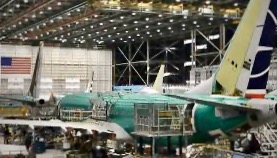 around the world. While EASA and other global regulators seem to have lost faith and confidence in U.S. primacy over aviation safety, the FAA itself signals that scrutiny of Boeing’s MAX/MCAS ‘fixes’ will be exacting, nose cone to tail nuts. This, in the face of revelations that Boeing management, test pilots and other employees have long taunted, derided and disregarded FAA inspectors with intra-company impunity, smugly dodging costly and “unnecessary” flight simulator training. In essence, self-certifying oversight was in free fall.
around the world. While EASA and other global regulators seem to have lost faith and confidence in U.S. primacy over aviation safety, the FAA itself signals that scrutiny of Boeing’s MAX/MCAS ‘fixes’ will be exacting, nose cone to tail nuts. This, in the face of revelations that Boeing management, test pilots and other employees have long taunted, derided and disregarded FAA inspectors with intra-company impunity, smugly dodging costly and “unnecessary” flight simulator training. In essence, self-certifying oversight was in free fall.
Now the chastened agency vows to painstakingly inspect and test software, AofA sensors—the entire MCAS flight control framework for airworthiness, plane by individual airplane, prior to any 737 MAX recertification. In fact, regulators have just fined the planemaker $5.9m for using unauthorized and defective flight-critical MAX wing slat-track parts.
Further issues impacting 737NG models as well include the outer shells of their engine nacelles, which were thinned by design for better wing and fuselage fit. The shaving down of 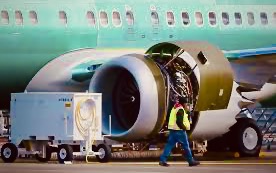 these covers and underlying layers of metal foil has resulted in their being more vulnerable to lightening strikes, thereby posing threats to fuel tanks and lines, affecting thrust control of the engines, risking “dual engine power loss events.” So the FAA has since posted an airworthiness directive requiring Boeing to rework the pods’ polishing/finishing process and replace weakened 737 carbon composite fairing panels before MAXes are cleared to fly again.
these covers and underlying layers of metal foil has resulted in their being more vulnerable to lightening strikes, thereby posing threats to fuel tanks and lines, affecting thrust control of the engines, risking “dual engine power loss events.” So the FAA has since posted an airworthiness directive requiring Boeing to rework the pods’ polishing/finishing process and replace weakened 737 carbon composite fairing panels before MAXes are cleared to fly again.
Couple that with weakness in GE/Safran engine rotors—having the potential of exploding, with fan blades breaking wildly away. Add in the possibility of two questionably designed wire bundles installed in all 737 variants (800 MAX jets, some 6,800 NGs), causing an electrical short. Running from upwards of 16-feet long to nearly the length of the mainframe, these closely paired bundles connect the flight control computer with a motor that adjusts the horizontal fin on a plane’s tail to navigate through and/or bridle (along with cockpit kill switches) any instances of stabilizer runaway.
For should the bundles short out, say on a power line too near as to be arcing on those stabilizer wires, the 737’s flight control system might force a catastrophic corrective nosedive. FAA and EASA techies prescribe moving the wiring bundles further away from each other along the length of the undercarriage.
This modification could take nearly two weeks per plane, further delaying key pre-certification flight testing. So Boeing holds that rerouting the wire bundles could be a delicate and costly task that might actually damage existing wire insulation. But wary regulators insist that the planemaker must comply to meet all recertification standards. Curiously, Boeing itself initially spotted the potential wiring problem, then notified the FAA.
Still another hang-up: faulty trim warning lights, which are meant to alert pilots when the 737’s trim system is not functioning properly. Add to that quality control issues such as Foreign Object Debris. FOD includes tools, ladders, sealant, even titanium shavings left by mechanics inside the fuel tanks of over 60% of undelivered 737 MAXes during maintenance and assembly. Such errant items could damage wing sensors and wiring, rags might clog vital fuel lines.
But similar charges of systemic shoddiness date back to 767/KC-46 military tankers and 787 Dreamliners, to a 2018 quality control audit of 747 and 777 programs. The most recent discovery may very well result in the draining of fuel tanks and thorough inspection of each and every 737 MAX craft prior to re-fly dates.
Then there is the latest 737 fiery crash, Ukrainian International Airline’s 800NG shortly after takeoff from Tehran killing 176—whether caused by a SAM missile or not—more bad 737 news. Or the Turkish low-cost Pegasus Airlines’ 737 that slid off a rain-slick Istanbul runway, breaking into three pieces, killing three—not that this mishap was 737 caused, but the relentless bad press doesn’t help Boeing’s cause.
Taken together, all these 737 concerns are now coming under intense examination by regulators the world over. More specifically, Administrator Dickson’s FAA also considers requiring mandatory flight-simulator training for all MAX jet pilots prior to ungrounding, (on upgraded TRU simulators at that), which the aerospace giant has finally acquiesced to provide—reversing its main 737 MAX ‘minimal training’ selling point in the process.
Otherwise, Boeing’s 777X, the world’s largest new commercial jetliner just can’t seem to leave its fuselage ruptures, oversized engine and expansive hinged wing problems behind. Nevertheless, the 777-9X behemoth has just successfully completed its initial flight into stormy Seattle skies—a bravura takeoff, at that—now facing a thunder squall of further scrutiny and testing before taxiing anywhere near inaugural service.
+ see: Jumboland: Inbound/Outbound.
Toward Righting the Corporate Airship.
Fixes, revisions, resets, tightening regulatory screws: To be sure, the now 10-month MAX grounding is costing the planemaker precious resources and time. So Boeing has been doggedly weathering the headwinds, buying into regulatory demands while spending vast capital and squandering brand equity, as its production schedules and timetables keep slipping away.
Already MAXed into a $10b hole, the company is looking to the credit markets for $5b in added debt to help fund related expenditures that could reach over $18.9b by Q3 2020. That is, even if 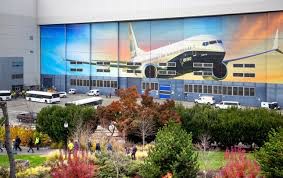 decertified 737 MAXes are cleared to return to operation by then. Boeing currently defers capital spending, halts acquisitions, slashes spending on R&D. Meanwhile, its share price has dropped by 22%, new orders nosediving to their lowest level since 2003, with the company’s combined 2019 revenue down 24% from 2018.
decertified 737 MAXes are cleared to return to operation by then. Boeing currently defers capital spending, halts acquisitions, slashes spending on R&D. Meanwhile, its share price has dropped by 22%, new orders nosediving to their lowest level since 2003, with the company’s combined 2019 revenue down 24% from 2018.
In any event, new CEO David Calhoun has his ‘turnarounder’ hands full, yet pledges by all means to do whatever it takes, go the extra recertifying mile to “get a safe plane back up in the sky and let it fly.”
Nevertheless, how will the planemaker aviate the route out of its MAXshaming spiral and spring back to aerospace prominence? Especially now that American, United and Southwest Airlines are extending their MAX re-fly dates well into fall, 2020. While Airbus SE struggles to keep up with surging demand for its rival narrow body A320neo and smaller A220 to fill the workhorse jetliner void, buying up its other competitor, Bombardier, Inc. to increase capacity. Fuel efficient, flexibly longer range: Neo production is now six months behind schedule, even though Airbus plans to raise output to 63-67 per month in coming years. This, as the U.S. and European aerospace giants otherwise spar over tax breaks and subsidies.
So what now? What will it in fact take to make this Boeing nightmare all right, all around? This is precisely what Vamigré will be following, gauging and enjoining from here to degrounding and beyond, what with so much riding on Boeing’s recovery.
Bottom line: will we travelers ever get onboard with this troubled aircraft, this 737 MAX ‘albatross’ again? Early surveys find we are currently a little less than halfway there. (MMTC…)
![]()
